RIGHT TURN ONLY!!
DurararaRTO!!
by Carlo Santos,

A new console generation is upon us, and the news out of this year's E3 was nothing if not momentous. However, as the legendary manga-ka Moto Hagio once told me, the greatest challenge facing comic artists today is how there are so many other forms of entertainment out there—including video games. I know she was talking about the consumer audience, but based on people I know, even artists themselves are as likely to be distracted by the siren song of a game controller...
ARE YOU ALICE?
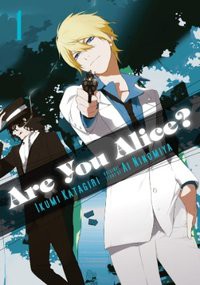
Vol. 1
(by Ikumi Katagiri and Ai Ninomiya, Yen Press, $11.99)
FROM THE BACK COVER:
"A disillusioned young man in search of 'something' stumbles into the weird and wacky world of Wonderland, where, as 'Alice,' he is thrust into a murderous game of 'Kill the White Rabbit' by command of the ruler of the land, the Queen of Hearts. But while Alice rails against the role that has been forced upon him, he has little choice but to comply. For in Wonderland, not sticking to the script can have deadly consequences..."
EVIDENCE FOR:
By now, pop culture is pretty oversaturated with "re-imagined Alice in Wonderland" projects. But Are You Alice?, which turns Lewis Carroll's tale into a cryptic life-or-death thriller, proves that there are still ideas worth exploring. What if the protagonist was an amnesiac young man, and what if he approached Wonderland's denizens with suspicion instead of curiosity? Armed with that attitude, this particular "Alice" instantly gives the series a strong kick-start. More importantly, the story's twisted logic captures Carroll's wit better than other spinoffs that skew toward fantasy or comedy. In this world, it's always six o'clock on the Mad Hatter's pocketwatch, you have a better chance of survival if you don't watch your back, and the central plot point is a strange loop where Alice and the White Rabbit are actually both hunting each other. The artwork also makes a number of original statements: Wonderland is now an elegant, Victorian-styled town instead of a rambling countryside, and deep contrasts of black and white give the visuals a noir-ish edge. Well-dressed characters, crisp lines, and carefully spaced panels and also add to the stylish look.
EVIDENCE AGAINST:
There's a thin line between being mysterious and being incomprehensible, and unfortunately, Are You Alice? crosses it too often. There's a running joke here that whenever Alice asks "Why?", another character brushes it off and says it's not his place to know. However, that's really just a weak attempt to conceal parts of the plot that haven't been worked out yet. What's more, the supporting characters often talk in vague terms, somehow hinting at their dark intentions—but the dialogue provides too little information to be interesting. Sudden scene changes also add to the confusion, especially with those creepy shots of the "other Alice(s)" that came prior to this story. The only scenes that mean something are the ones where Alice is taking action or communicating with other characters; everything else is atmospheric fluff. The sparse art style seems lacking in substance as well, with backgrounds left out of many scenes (the Victorian scenery appears only when convenient), and not enough screentones to bridge the gaps between pure black and white. It's as if 20% of this series is strangely missing.
FINAL VERDICT:
The story and art would both benefit from being more concrete, but the cryptic atmosphere and polished style earn this volume a passable B-.
ATTACK ON TITAN

Vol. 5
(by Hajime Isayama, Kodansha Comics, $10.99)
FROM THE BACK COVER:
"Thanks to Eren, humanity has taken the town of Trost back from the Titans. Exhausted, Eren falls into a coma for three days—and wakes in shackles, staring at Erwin Smith, leader of the Survey Corps. Certain that Eren's father's research holds the key to the mystery of the Titans' rise, Smith wants an expedition to retrieve it from the house where Eren grew up. But that's deep in Titan territory, and to get there Eren will need to master a power he still doesn't fully understand..."
EVIDENCE FOR:
Attack on Titan goes through something of an evolution in this volume—instead of just endless battles and scattered flashbacks, this one pulls everything together into a more substantial storyline. A courtroom scene between Eren and the authorities turns surprisingly philosophical, as politicians, generals, merchants, and even the clergy argue about what to do with the boy and his powers. Later on, a researcher reveals some unusual scientific observations about the Titans, altering our standard perception of them as man-eating monsters. And who can forget that stirring yet terrifying speech where Commander Erwin warns new trainees of what it means join the Survey Corps? Meanwhile, the storyline still dishes out a plenty of heart-pounding action scenes, especially when the Survey Corps are trying to outrun various Titans in the wild. Eventually they're forced to engage in direct combat, and that's when the artwork really steps up: sharp, slashing speedlines, exaggerated perspective, and tilted viewpoints add dynamism to every scene. Heavy, hand-drawn shading and the characters' grim expressions also emphasize the seriousness of the moment. A warped sense of human anatomy also helps to make the Titans look twisted and scary from every angle.
EVIDENCE AGAINST:
Bending the rules of anatomy to make monsters more monstrous is fine, but when you have trouble drawing the main characters consistently ... that's when a plus becomes a minus. Stiff poses and awkward faces are still a problem here, although not as much as in earlier volumes. The rough, sketchy style can also make character designs hard to pick out—Eren looks like all the other dark-haired guys, for example. Meanwhile, an overload of medium-gray screentones ends up being a drag on certain scenes, most of which were already boring in the first place because of content. Yes, there's a lot of dense, high-minded dialogue in Eren's trial, and even the sheer passion of the characters doesn't change the fact that they're just standing and arguing. The middle chapters, with their emphasis on recaps, discussion, and introspection, also lack a strong action element. Are these folks going to talk about battle tactics and the horrors of war, or are they going to go out and fight some Titans? Even as the storyline expands, it should stay in touch with what it does best.
FINAL VERDICT:
If the art were more consistent, it could get an even higher grade, but new wrinkles in the story and thrilling bursts of action still make this volume worth a B.
DURARARA!! SAIKA ARC

Vol. 2
(by Ryohgo Narita, Akiyo Satorigi and Suzuhito Yasuda, Yen Press, $11.99)
FROM THE BACK COVER:
"A mysterious serial slasher has struck in Ikebukuro. The username 'Saika' appears in online chat rooms in sync with the attacks. Saika—the name of the demon blade that appeared in Shinjuku years and years ago...
In its chat room posts, Saika repeats one name over and over again, as if singing the praises of its beloved: Shizuo Heiwajima, Shizuo, Shizuo..."
EVIDENCE FOR:
Shizuo's confrontation with a knife-wielding maniac is the highlight of this volume—just look at what he does with a car door!—but it's all the other characters, and their surprising connections, that really give the story its spark. The personal struggles of schoolgirl Anri Sonohara are explored further, and then she gets pulled into the heart of the Saika crisis, thus rounding out a story arc that felt incomplete last time. Meanwhile, headless rider Celty teams up with Shizuo to solve the serial slasher case, resulting in an intense bike ride around Ikebukuro and a back-alley showdown with all the hand-to-hand combat a fan could ask for. The story kicks into an even higher gear in the last chapter, where shocking events reveal that the idea of a "demon blade" can be interpreted in many different ways. The artwork excels in bringing out the suspense of this story arc, with lots of deep-black shadows and dimly lit streets to set the mood. At the same time, artist Akiyo Satorigi never misses a chance for a great fight; distinctive character poses and clean linework make every action sequence a slick, fast-paced affair.
EVIDENCE AGAINST:
Yes, the artwork always looks polished and clean—sometimes too clean. Backgrounds are often abbreviated or ignored entirely, and some dialogue scenes are so sparsely illustrated that one forgets where the characters are while they're speaking. This arc also has story elements that are there just for the sake of being there—namely, the gang of boys who always hang out in a van. They have no major bearing on the plot, they barely did anything last volume, yet they conveniently pop up as a deus ex machina when one of the major characters gets in serious trouble. The storytelling also dips into too much one-sided narration and back-story from time to time, a sure sign that the manga is adapted from a novel (and trying too hard to fit all the words in). When Dr. Shinra trots out a lecture about the supernatural intentions of the Saika blade, or Anri launches into an internal monologue about her troubled past, the wordiness diminishes the importance of this being a visual medium.
FINAL VERDICT:
The storytelling isn't always perfect, but it does plenty of other things right: crisscrossing subplots, mysteries surrounding each character, and masterful action scenes that add up to an A-.
NURA: RISE OF THE YOKAI CLAN
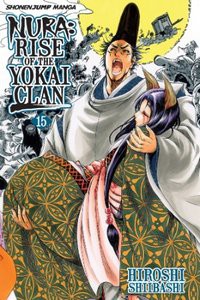
Vol. 15
(by Hiroshi Shiibashi, Viz Media, $9.99)
FROM THE BACK COVER:
"While the day belongs to humans, the night belongs to yokai, supernatural creatures that thrive on human fear. Caught between these worlds is Rikuo Nura. He's three-quarters human, but his grandfather is none other than Nurarihyon, the supreme commander of the Nura clan, a powerful yokai consortium. So, Rikuo is an ordinary teenager three quarters of the time, until his yokai blood awakens. Then Rikuo transforms into the future leader of the Nura clan, leading a hundred demons.
As the ancient yokai Hagoromo-Gitsune prepares to give birth to the new reincarnation of Nue, ancestor to the world-killing Gokadoin clan, Rikuo rushes to learn new skills and battle moves that will ready him for his biggest battle yet."
EVIDENCE FOR:
Volume 15 is the all-smashing, all-crashing volume of Nura where Rikuo faces Hagoromo-Gitsune at last. Yet there's also plenty of excitement beforehand: when Rikuo combines his powers with walking arsenal Kurotabo, the sight of a thousand blades poking out of the hero's robes is simply breathtaking. The only thing more breathtaking is seeing him wield those blades against a swordsman whose abilities are just as unreal. Rikuo's supporting cast is also impressive; the thick-lined, brushstroke art brings out the Keikain clan's mystical powers in all their glory. (The best technique? Seeing streams of writing turn into a physical weapon.) However, this volume's shining moment still belongs to Hagoromo-Gitsune, who summons a giant demon baby—another visual jaw-dropper—and gives Rikuo all he can handle in the final fight. Fragmented memories floating in mid-air, plus a thousand years of history, add mystery and wonder to the battle, and the chain of attacks where Rikuo and friends assist each other in delivering the finishing blow makes for a perfectly paced climax. Now the only problem is: how are they ever going to top that?
EVIDENCE AGAINST:
When the pro side of the argument is basically a laundry list of fight scenes, you know you've got trouble. Sure, this volume delivers on the hype—but does it accomplish anything else? The climactic battle is almost nonsensical, with random characters ("Hey, remember this guy from five volumes ago?") jumping in and unleashing their best moves. Funnily enough, it's often the exact move that's needed at that moment—which is more lazy plotting than it is lucky coincidence. Even worse is when the opposing party counters it by saying, "Aha, that was a good move, but I just happen to have one that's slightly better!...." Basically, it's a supernatural free-for-all with all the brawn and none of the brains. The chaos also extends to the artwork, which goes overboard in trying to be spectacular. Foregrounds and backgrounds clash with each other, and the characters are so elaborately drawn that it's hard to tell what they're doing. Even full-page spreads are crammed with superficial flourishes that might look good on a poster, but do nothing to tell the story.
FINAL VERDICT:
Normally, big story-arc-ending fight scenes get a good grade just for being what they are, but this one is such a mess that it gets the mark of mediocrity with a C.
PSYREN
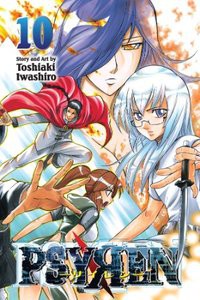
Vol. 10
(by Toshiaki Iwashiro, Viz Media, $9.99)
FROM THE BACK COVER:
"Ageha Yoshina just got transported to a warped alternate dimension where you've got to fight your way back to our world—or die trying.
Ageha finally manages to rescue Nemesis Q's creator, and she reveals the stunning true purpose of the Psyren game! Meanwhile, the missing Hiryu and Oboro have survived but are left behind while Ageha, Amamiya, and Kabuto return home without them..."
EVIDENCE FOR:
If Volume 9 of Psyren was a fireworks show, then Volume 10 is the smoke that follows—hazy, mysterious, and crawling with surprises. This is where the mastermind behind Nemesis Q finally speaks out and explains the origin of the Psyren game, which (much like W.I.S.E.'s world domination plan) connects the apocalyptic future to the present day. What's more, the relationship between Nemesis Q's creator and W.I.S.E. is revealed in one of those brilliant, surprising-yet-not-surprising-at-all twists. These intertwined plot lines are what make Psyren so addictive, even when not in battle mode—there's so much to discover, and every time you think you've got it figured out, it takes another wild turn. The next stage, where Ageha sets out to (hopefully) stop W.I.S.E. from ever getting started, also plants the seeds of conflict for chapters to come. The artwork, while not as spectacular at last time, still finds ways to impress: wandering sidekicks continue to fight for survival in a harsh, otherworldly landscape, and a metaphor about the "bridge" between present and future explains time travel better than words could. Sharp linework and striking character designs also add visual appeal.
EVIDENCE AGAINST:
If there's one thing to be learned from this volume, it's that Psyren could probably use a better balance between action and exposition. After the mindless, Michael Bay-esque shootout on Dreameater Island, we now get several chapters of head-spinning, mystical pronouncements, with nary a psychic attack in sight. Sure, there's some action wedged into the middle, but it's really just filler designed to shuffle some side characters out of the way—"Here's what the other guys are up to; now forget about them." In any case, do the sidekicks even matter that much to Ageha's overall quest? Like many elaborately scripted adventures, this one is simply juggling too many people and motives at once. The latter part of the volume, where Ageha tries to get situated with his new mission, also lacks the intrigue of the first half where all of Nemesis Q's secrets came pouring out. Meanwhile, page layouts look awfully static in some of the dialogue scenes: one square panel after another, with the characters posed in mundane fashion. Ah, the struggles of action manga when there isn't any action going on...
FINAL VERDICT:
The series continues to succeed with its dense, ever-twisting storyline and solid artwork, but too much standing-and-talking averages out to a B-.

WITCH AND WIZARD
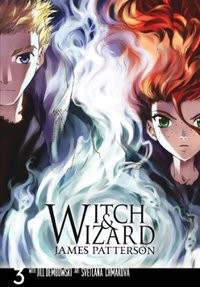
Vol. 3
(by James Patterson, Jill Dembowski and Svetlana Chmakova, Yen Press, $12.99)
FROM THE BACK COVER:
"Although Whit and Wisty's magic and their control over it have matured, they still find themselves helpless to prevent The One Who Is The One from destroying everyone and everything they hold dear. But there's a reckoning on the horizon, and the siblings have no choice but to devise a strategy to topple with one decisive blow the tyrant who has devastated their world before he becomes truly all-powerful..."
EVIDENCE FOR:
Witch and Wizard reaches a grand, pyrotechnic finale in this volume, and while it's no seventh Harry Potter novel, it certainly tries for that kind of dramatic sweep. This one swings all the way across the emotional pendulum, from tear-jerking gestures of hope (Whit and Wisty share a December 25th "Holiday" celebration with a group of allies), to unspeakable fear and despair (Wisty coming face to face with the One himself), and all the magic-wielding, tyranny-battling action in between. We even get to hear the One's back-story at last—a tale of misguided youth that fills in the gaps about where evil comes from in this world. The last battle, where Whit and Wisty take on the One in the "Shadowland" between life and death, is everything one could hope for in a blockbuster: part supernatural, part science fiction, and completely exhilarating. The artwork, too, has matured as much as the characters have, with subtle details and dramatic curves in all the right places. Magical attacks and other special effects amaze the eye without obscuring the action, while clear panel layouts guide this story to its thrilling, quick-paced conclusion.
EVIDENCE AGAINST:
Was this constructed from a "How to do the action genre" DIY kit, or what? All the pieces fall where they're supposed to, but that seems more the result of following a formula than letting the narrative play out logically. Every time Whit and Wisty are on the verge of failure, someone comes out of nowhere to save their butts—sometimes literally, as in the case of a mentor who teleports to their location. Also, these supporting characters often end up nudging the two in the right direction, turning this into an on-rails quest instead of letting the kids figure it out for themselves. Later on, Whit and Wisty split up to chase different goals, another questionable decision that forces the story to flip-flop between two different scenarios instead of maintaining continuity. Some shaky logic also awaits at the end, when it turns out that Whit and Wisty's actions fulfill a never-before-mentioned prophecy. Aside from this paint-by-number storytelling, the varied character designs suddenly become hard to keep track of in this final arc, simply because of all the people who re-emerge from earlier points in the story.
FINAL VERDICT:
The adherence to blockbuster formula stops it from being a truly groundbreaking work, but it's still a lot of fun as good triumphs over evil in an explosive finale.
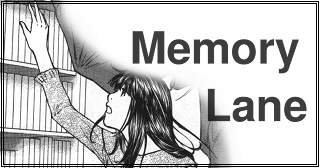
MOYASIMON

(by Masayuki Ishikawa, Del Rey)
If you want to know the definition of anguish, consider the fact that it's only been a couple of years and already Moyasimon is fading into obscurity—an unfortunate victim of the Del Rey/Kodansha Comics restructuring. Sadly, this is what happens to really good manga that's only liked by a small fraction of the fandom with really odd tastes.
Indeed, nothing exemplifies the "odd but good" niche quite like Moyasimon, which touches on the highly specialized subject of bacteria. Yes, you heard that right. Main character Tadayasu Sawaki has the unusual ability to see micro-organisms with the naked eye, and as a first-year student at an agricultural university, he ends up using that ability a lot. Sawaki's escapades include digging up fermented animal carcasses, delving into the art of sake-brewing, and trying to diagnose a flu epidemic—all because he can see bacteria, viruses, and other teeny-tiny life forms as adorable little mascot characters. And if they had come out with more volumes besides the first two, I could probably expound further on what happens to this curious young lad.
The cutesy microbe illustrations are easily the best thing about the artwork; Ishikawa's style outside of that is distinctive (big eyes and bold lines) but lacking in craftsmanship (stiff anatomy and off-kilter proportions keep the human characters from looking entirely convincing). What Ishikawa lacks in pure talent, though, he makes up for with effort and detail—just look at some of those nasty, germ-ridden college dorms!—as well as a sharp sense of humor. The characters are all quirky and likable, and the scrapes they get into combine a sense of whimsy with hardcore microbiology trivia. And yet, even if this did get license-rescued, it probably wouldn't make enough sales to be worth it. Still, fans with odd tastes can dream, can't they?
discuss this in the forum (3 posts) |